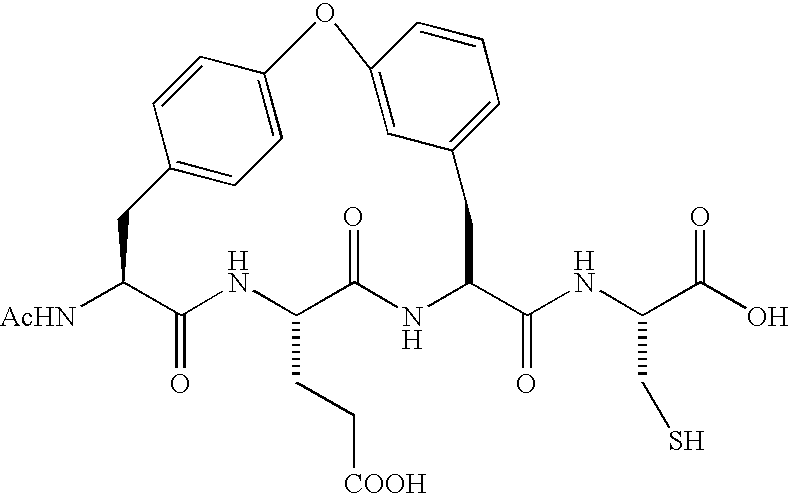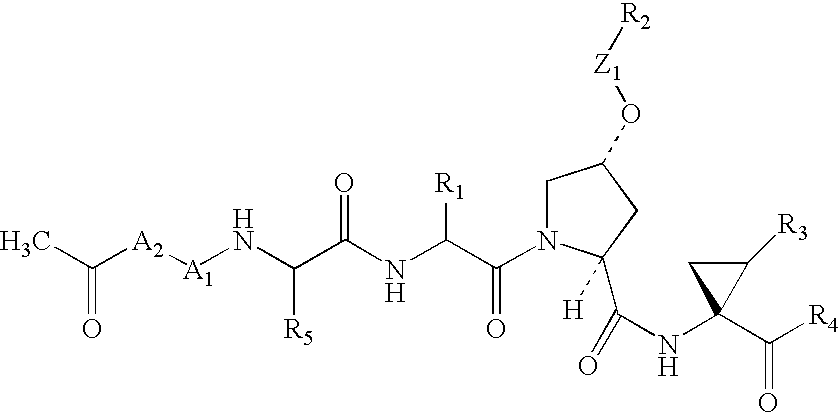Depeptidized inhibitors of hepatitis C virus NS3 protease
a technology of hepatitis c virus and protease inhibitor, which is applied in the direction of peptides, cyclic peptide ingredients, drug compositions, etc., can solve the problems of low sustained response rate of therapies, frequent side effects, and poor treatment progress of patients with hcv infection
- Summary
- Abstract
- Description
- Claims
- Application Information
AI Technical Summary
Benefits of technology
Problems solved by technology
Method used
Image
Examples
example 1
Preparative Example 1
[0203]
Step A:
[0204]
[0205]A solution of Boc protected compound 1a (Tsantrizos et al. U.S. Pat. No. 6,608,027 B1 (Boehringer Ingelheim, Canada), 2.2 g, 3.166 mmol) in HCl (4 M soln in dioxane 50 mL) and CH2Cl2 (50 mL) is stirred at rt. for 1 h and concentrated in vacuo. The disappearance of starting material is followed by TLC (acetone / hexanes 1:1). The gelatinous reaction mixture is concentrated in vacuo and dried to yield 1b that is used in next reaction without further purification.
Step B:
[0206]
[0207]A solution of amide 1b (18 g, 64.67 mmol) in toluene (200 mL) is treated with BH3.DMS (2 M soln. in THF, 65 mL, 130 mmol) and heated at 80° C. for 3 h. The reaction mixture is cooled to rt and treated carefully with aq NaOH (2 M) and extracted into CH2Cl2 (3×200 mL). The combined organic layers were extracted with aq. saturated NaHCO3 (3×300 mL), brine (300 mL), dried (MgSO4) and purified by chromatography (SiO2, ammoniacal methanol (7M) / CH2Cl2 1:20) to yield 1c (3...
example 2
Preparative Example 2
[0224]
Step A:
[0225]
[0226]A solution of Boc protected compound 2a (WO 00 / 09558 (Boehringer Ingelheim, Canada) in HCl (4 M soln in dioxane) and CH2Cl2 is stirred at rt. and concentrated in vacuo. The disappearance of starting material is followed by TLC (acetone / hexanes 1:1). The gelatinous reaction mixture is concentrated in vacuo and dried to yield 2b that is used in next reaction without further purification.
Step B:
[0227]
[0228]A solution of amide 2c (18 g, 64.67 mmol) in toluene (200 mL) is treated with BH3.DMS (2 M soln. in THF, 65 mL, 130 mmol) and heated at 80° C. for 3 h. The reaction mixture is cooled to rt and treated carefully with aq NaOH (2 M) and extracted into CH2Cl2 (3×200 mL). The combined organic layers were extracted with aq. saturated NaHCO3 (3×300 mL), brine (300 mL), dried (MgSO4) and purified by chromatography (SiO2, ammoniacal methanol (7M) / CH2Cl2 1:20) to yield 2d (3.5 g) as a colorless oil.
Step C:
[0229]
[0230]A solution of 2d (900 mg, 3.40 ...
example 3
Preparative Example 3
[0238]
Step A:
[0239]
[0240]Potassium bis(trimethylsilylamide) (KHMDS), (200 ml of a 0.5M solution in toluene) was added, drop wise to a stirred solution of methyl cyclohexanecarboxylate 3a (11.1 g; 78 mmol) in anhydrous tetrahydrofuran (200 ml), at −78° C. under an atmosphere of nitrogen. When the addition was complete the reaction was maintained at this temperature for a further 0.5 h. before the addition of benzylchloromethyl ether (18.6 ml; 134 mmol). The reaction was allowed to warm to room temperature overnight and water (100 ml) was added. Aqueous work-up provided a residue which was purified by silica gel column chromatography using EtOAc; hexanes (1:10) as eluent to give the benzyl ether which was used in the next step (14.98 g)
[0241]A black suspension of 10% Pd / C (0.5 g) and the aforementioned crude ether (4.1 g) in methanol (80 ml) was exposed to an atmosphere of hydrogen (balloon) at room temp. overnight. The reaction was filtered through a pad of celit...
PUM
| Property | Measurement | Unit |
|---|---|---|
| pH | aaaaa | aaaaa |
| pH | aaaaa | aaaaa |
| pH | aaaaa | aaaaa |
Abstract
Description
Claims
Application Information
 Login to View More
Login to View More - R&D
- Intellectual Property
- Life Sciences
- Materials
- Tech Scout
- Unparalleled Data Quality
- Higher Quality Content
- 60% Fewer Hallucinations
Browse by: Latest US Patents, China's latest patents, Technical Efficacy Thesaurus, Application Domain, Technology Topic, Popular Technical Reports.
© 2025 PatSnap. All rights reserved.Legal|Privacy policy|Modern Slavery Act Transparency Statement|Sitemap|About US| Contact US: help@patsnap.com



